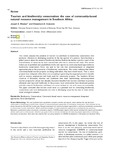Please use this identifier to cite or link to this item:
http://hdl.handle.net/10311/1326| Title: | Tourism and biodiversity conservation: the case of community-based natural resource management in southern Africa |
| Authors: | Mbaiwa, Joseph E. Kolawole, Oluwatoyin D. |
| Keywords: | Biodiversity Conservation Community-based natural resource management Integrated approaches Rural development |
| Issue Date: | 10-Jan-2013 |
| Publisher: | CAB International Publishing, www.cabi.org |
| Citation: | Mbaiwa, Joseph E. & Kolawole Oluwatoyin D. (2013) Tourism and biodiversity conservation: the case of community-based natural resource management in southern Africa, CAB Reviews , Vol. 8, No. 10, pp. 1-10. |
| Abstract: | This review analyses the potential of tourism to contribute to biodiversity conservation with particular reference to developing countries. In the last quarter of a century, there has been a global concern about the extent of biodiversity decline. Biodiversity decline is partly a result of the overutilization of resources by local communities who live in resource-rich areas. This review makes use of published and unpublished articles and reports on community-based approaches to biodiversity conservation. Focus was paid to the role that community-based or integrated approaches play in the promotion of biodiversity conservation. The review indicates that where community-based tourism projects are being undertaken, they have mixed results. That is, some projects have collapsed, while others are succeeding in generating the expected economic benefits such as income, employment and funds used for community projects. The Southern African countries of Botswana, Namibia and Zimbabwe have been implementing community-based tourism projects for almost two decades. Economic benefits from tourism contribute to poverty alleviation and improved livelihoods. In the process, local communities have developed positive attitudes towards biodiversity, and hence are more inclined to use such resources sustainably. The paper concludes that tourism could serve as a potential tool for stimulating biodiversity conservation and rural development not only in developing countries but also in other similar social–ecological contexts. |
| URI: | http://hdl.handle.net/10311/1326 |
| ISSN: | 1749-8849 (online) |
| Appears in Collections: | Research articles (ORI) |
Files in This Item:
| File | Description | Size | Format | |
|---|---|---|---|---|
| CAB paper - PAV010_2013 [Responses to queries in sticky notes].pdf | Main article | 114.22 kB | Adobe PDF |  View/Open |
Items in DSpace are protected by copyright, with all rights reserved, unless otherwise indicated.
